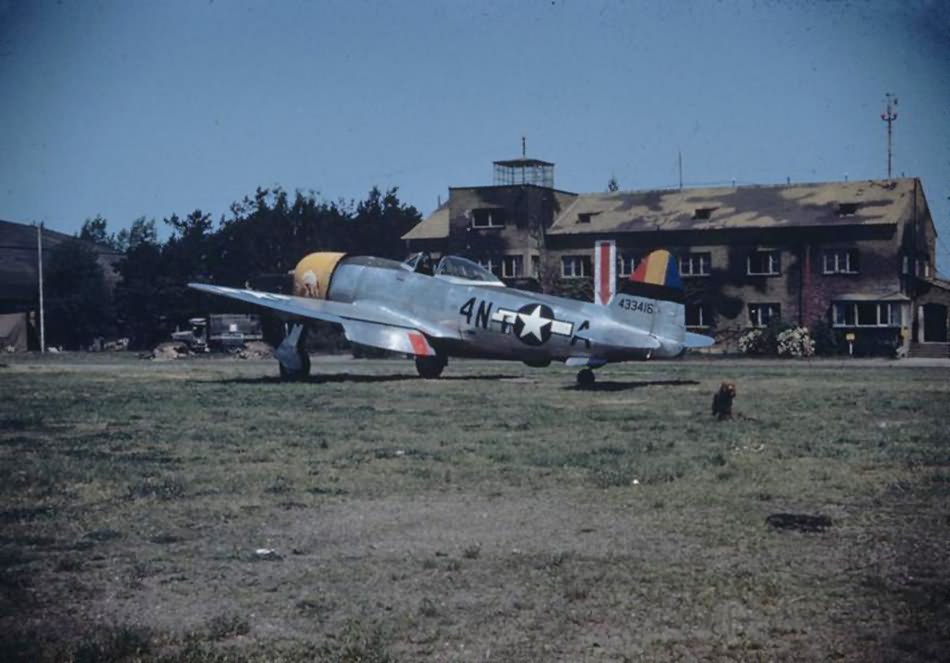The 367th Fighter Group (367th FG), known as “The Dynamite Gang,” was a formidable unit within the Ninth Air Force during World War II. Initially trained on P-39s in the United States, the group transitioned to P-38 Lightnings upon its arrival in England in April 1944 and later to P-47 Thunderbolts in early 1945. Detailed overview of the group’s operations, structure, and contributions:
Operational History
Arrival and Early Operations:
- After arriving in England in April 1944, the 367th FG quickly transitioned from P-39s to P-38 Lightnings. The group began its combat operations on 9 May 1944, focusing on strike missions in western France and providing escort to heavy bombers in the same region.
D-Day and Normandy Campaign:
- On D-Day (6 June 1944), the 367th FG provided air cover for Allied forces crossing the English Channel. The group was also involved in strafing and attacking various targets behind the invasion beaches, playing a crucial role in the success of the Normandy landings.
- Move to France: In July 1944, the 367th FG moved to France, where it continued to support ground forces by targeting enemy supply lines and preventing reinforcements from reaching the front. A notable mission on 25 August 1944, where the group attacked enemy airfields, strafed a train, and hit a road convoy through heavy flak, earned the 367th FG a Distinguished Unit Citation (DUC).
Siege of Bastogne and Ardennes Offensive:
- During the autumn of 1944, the 367th FG supported the Allied push through the Siegfried Line. On 26 December 1944, the group provided crucial air cover for C-47s dropping supplies to besieged Allied troops in Bastogne during the Battle of the Bulge.
Transition to P-47 Thunderbolts:
- In February 1945, the 367th FG transitioned from P-38s to P-47 Thunderbolts. Despite the change in aircraft, the group continued its aggressive operations, earning a second DUC for a daring attack on the heavily defended headquarters of the German Commander-in-Chief West at Ziegenburg on 19 March 1945.
Final Operations and End of War:
- Toward the end of the war, the 367th FG supported the Allied assault across the Rhine River and participated in the final drive into Germany. The group’s last mission took place on 8 May 1945, coinciding with VE-Day.
- Post-War: After the war ended, the 367th FG returned to the United States during July and August 1945, where it was deactivated later that year.
Unit Decorations
- Distinguished Unit Citations (DUC):
- France: 25 August 1944.
- Germany: 19 March 1945.
- Belgian Army Order of the Day:
- 6 June 1944 – 30 September 1944
- 16 December 1944 – 25 January 1945
- Belgian Fourragere: Awarded for exceptional service during operations in Belgium.
Overseas Combat Commanders
- Col. Charles M. Young: Commanded from 22 January 1944.
- Col. Edwin S. Chickering: Took command on 9 November 1944.
Overseas Stations
- England:
- Stoney Cross, Hampshire: 5 April 1944.
- Ibsley, Hampshire: 6 July 1944.
- France:
- Beuzeville, Basse-Normandie: 22 July 1944 (HQ only).
- Criqueville, Basse-Normandie: 14 August 1944.
- Peray, Basse-Normandie: 4 September 1944.
- Clastres, Picardie: 8 September 1944.
- Juvincourt, Champagne-Ardenne: 28 October 1944.
- St. Dizier, Champagne-Ardenne: 1 February 1945.
- Conflans, Lorraine: 14 March 1945.
- Germany:
- Frankfurt/Eschborn, Hessen: 10 April 1945.
Squadrons, codes and Aircraft
- Fighter Squadrons:
- 392nd Fighter Squadron (FS): H5
- 393rd Fighter Squadron (FS): 8L
- 394th Fighter Squadron (FS): 4N
- Aircraft:
- P-38 Lightning (April 1944 – February 1945):
- The P-38s were initially marked with black geometric symbols (triangle, circle, square) on the tailplane, with colored nose tips and spinners to denote squadron affiliation.
- P-47 Thunderbolt (February 1945 – July 1945):
- The P-47s featured squadron colors on the cowling and the upper fin and rudder, with each squadron’s color scheme continuing the geometric tailplane markings from the P-38s.
- P-38 Lightning (April 1944 – February 1945):
Aircraft Markings
- 392nd FS:
- P-38s: Black triangle on the tailplane, red nose tip, and spinner.
- P-47s: Red cowling, with red/yellow/blue upper fin and rudder.
- 393rd FS:
- P-38s: Black circle on the tailplane, blue nose tip, and spinner.
- P-47s: Blue cowling, with red/yellow/blue upper fin and rudder.
- 394th FS:
- P-38s: Black square on the tailplane, yellow nose tip, and spinner.
- P-47s: Yellow cowling, with red/yellow/blue upper fin and rudder.
